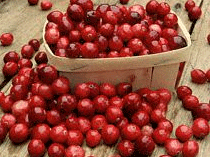New Jersey's Cranberry Crop
 The first known harvesters of the cranberry in the state, the Lenni-Lenape used the wild red berry for food. From here, "cranberrying" became a major industry in NJ, with approximately 3,500 acres under cultivation, ranking third in the nation in cranberry production with about 10 percent of the total national output.
The first known harvesters of the cranberry in the state, the Lenni-Lenape used the wild red berry for food. From here, "cranberrying" became a major industry in NJ, with approximately 3,500 acres under cultivation, ranking third in the nation in cranberry production with about 10 percent of the total national output. Cranberry cultivation in NJ is believed to have begun in 1840 by John Webb, who established a cranberry bog in Ocean County. It is reported that he received $50 per barrel for his cranberries, which were bought by ship merchants, who sold them to whalers. Cranberries were kept on board ships in barrels of cold water for the sailors to eat. They contained Vitamin C and helped ward off scurvy, which plagued seafarers on long trips.
The state's leading cranberry grower is William S. Haines of Chatsworth, who has over 700 acres planted in cranberry vines. The Haines family has a history of cranberry growing. Grandfather Cap Haines, a Civil War veteran, built cranberry bogs in an area known as The Birches in the 1890s. Ethelbert and Ralph Haines (William’s father and uncle) developed the extensive Chatsworth property and named it Hog Wallow. The former wilderness area yields an average of 100 barrels of cranberries per acre, with a total annual crop of about 70,000 barrels.
First experiments with the wet pick method of harvesting were carried out in 1962, and Haines was a wet pick pioneer. Today, Haines harvests his entire crop by this method, which enables him to harvest 95% of the berries in 60% of the time it formerly took him to dry pick. The shortened harvest time also decreases the danger of crop damage by frost.
To wet pick, floodgates on the reservoir feeding the selected area are opened and water flows into the ditches and over the vines to a depth of about 18 inches, just enough to allow the water reel, which resembles a large egg beater, to work. The rapidly rotating water reels stir up the water with sufficient force to dislodge the ripened-cranberries, which float to the surface in a brilliant red mass of color. The berries are corralled to one side of the bog where they are removed from the water to waiting trucks. Most of New Jersey's growers truck their berries to the Ocean Spray cooperative in Bordentown for immediate drying, but Haines has his own sorting house because of the great volume of his cranberry operation. In his sorting house, the first step is to remove grass and leaves from the berries. The berries are put on rubber belts. The leaves and grass stick to the rubber, riding up the belts to be dumped. The berries roll down to another conveyor which takes them to the dryer, which consists of an inclined screen built over air chambers. As the berries pass down this screen, hot air is blown on them, and then cool air.
The, the berries go through a series of steps to ensure that only the best make it to the market. First, the berries go through a “bouncer.” If the berries are not firm enough to bounce, they drop down to discard bins. Berries that bounce are screened by inspectors who remove any fruit not up to Ocean Spray standards. At Haines' sorting house, the screened berries go into a hopper to be weighed and boxed for shipment to Bordentown, where the cooperative takes over for processing and marketing.
In the early days, before the advent of harvesting machinery, cranberries were first picked by hand and then by the use of hand scoops which combed the berries from the vines. Development of mechanical pickers began after World War II. Now nearly all of the country's cranberries are brought in by mechanical pickers. The Darlington picker, widely used by growers in all areas where dry harvesting is practiced, was invented by Thomas B. Darlington, a cranberry grower in New Lisbon, New Jersey. Resembling a power lawn mower, it is pushed along the dry bog by a worker. The rotating teeth scoop into the vines and lift off the fruit, which is carried by a conveyor belt to a removable container attached to the handle bars.
The cranberry harvest begins in New Jersey shortly after Labor Day and extends through October. If frost threatens, the vines must be protected. This is done by flooding the bogs well over the top of the vines. When the water freezes to depth of about 8 inches, the water underneath the protective coating is drained away so the vines can breathe. In the summer the vines must be irrigated during hot, dry spells. Other essentials in cranberry care are fertilizing, pruning of the vines, and weeding.
Burlington, Atlantic, and Ocean counties are major cranberry growing areas in New Jersey. The native fruit is also grown in Camden, Cape May, Cumberland, Gloucester, Middlesex, and Monmouth counties.
For more South Jersey History, visit our History page.
advertisement

Author: R. Cohen
Archives
Collingswood
A Southern Mansion
Light up the Night
Dining Alfresco
Sink or Swim
Throwing Shade
The Outdoors in Order
The Foundation
A New Spin on Swim
Gloucester Township
Wonderful Water
The Foundation: June, 2015
Community Connection: Moorestown
Things to Do
Cinnaminson
More...







